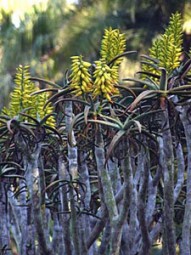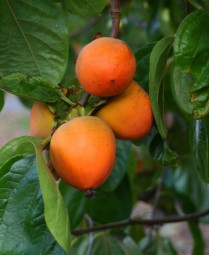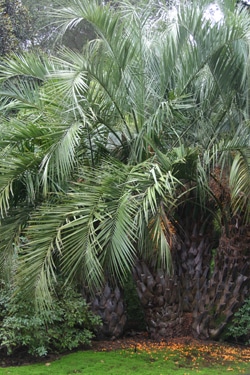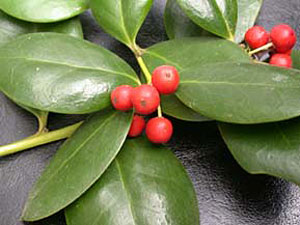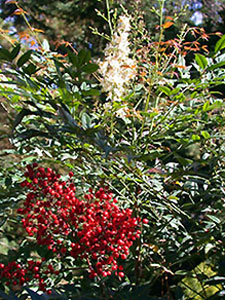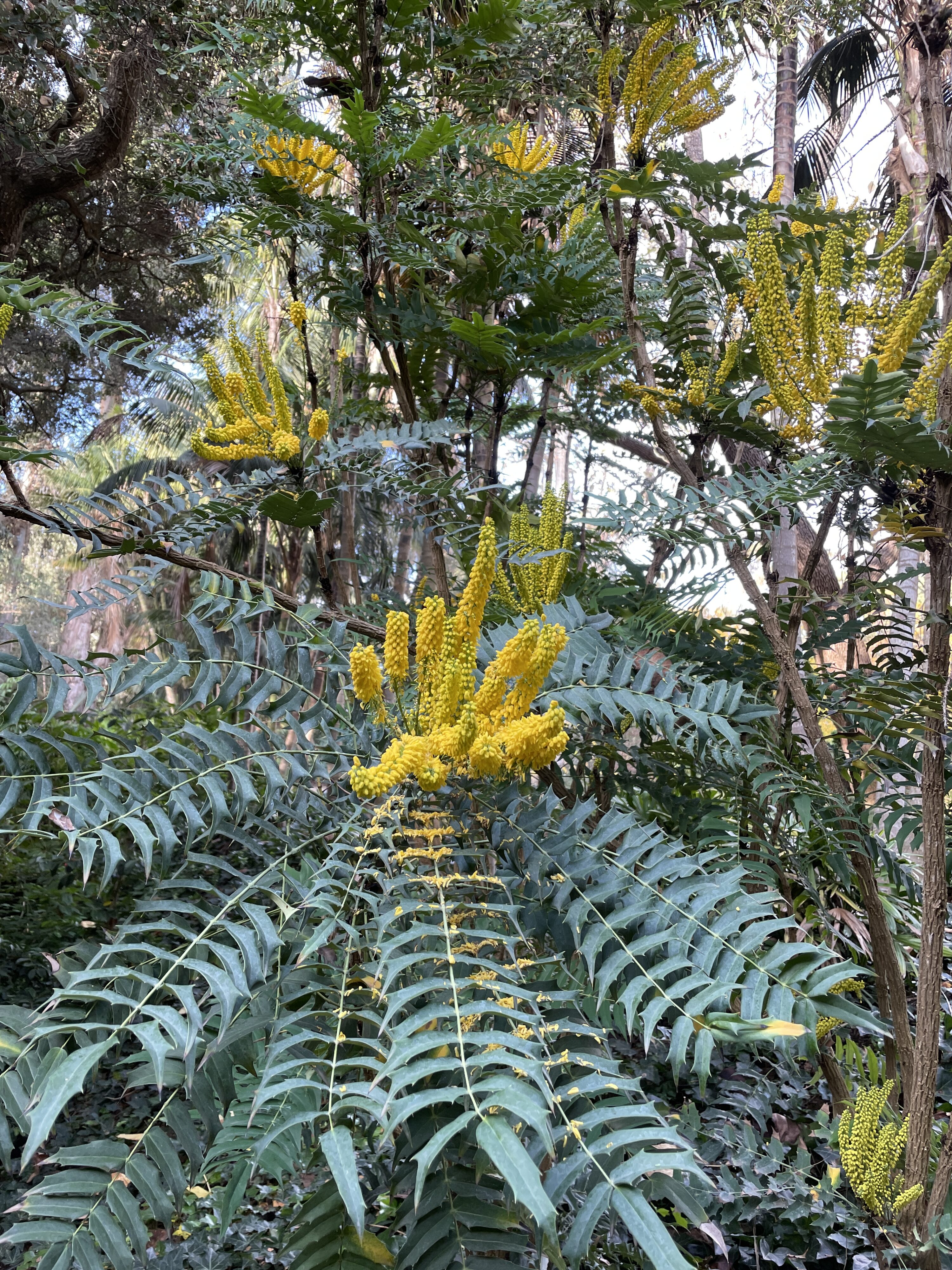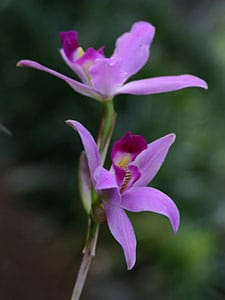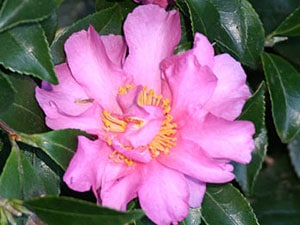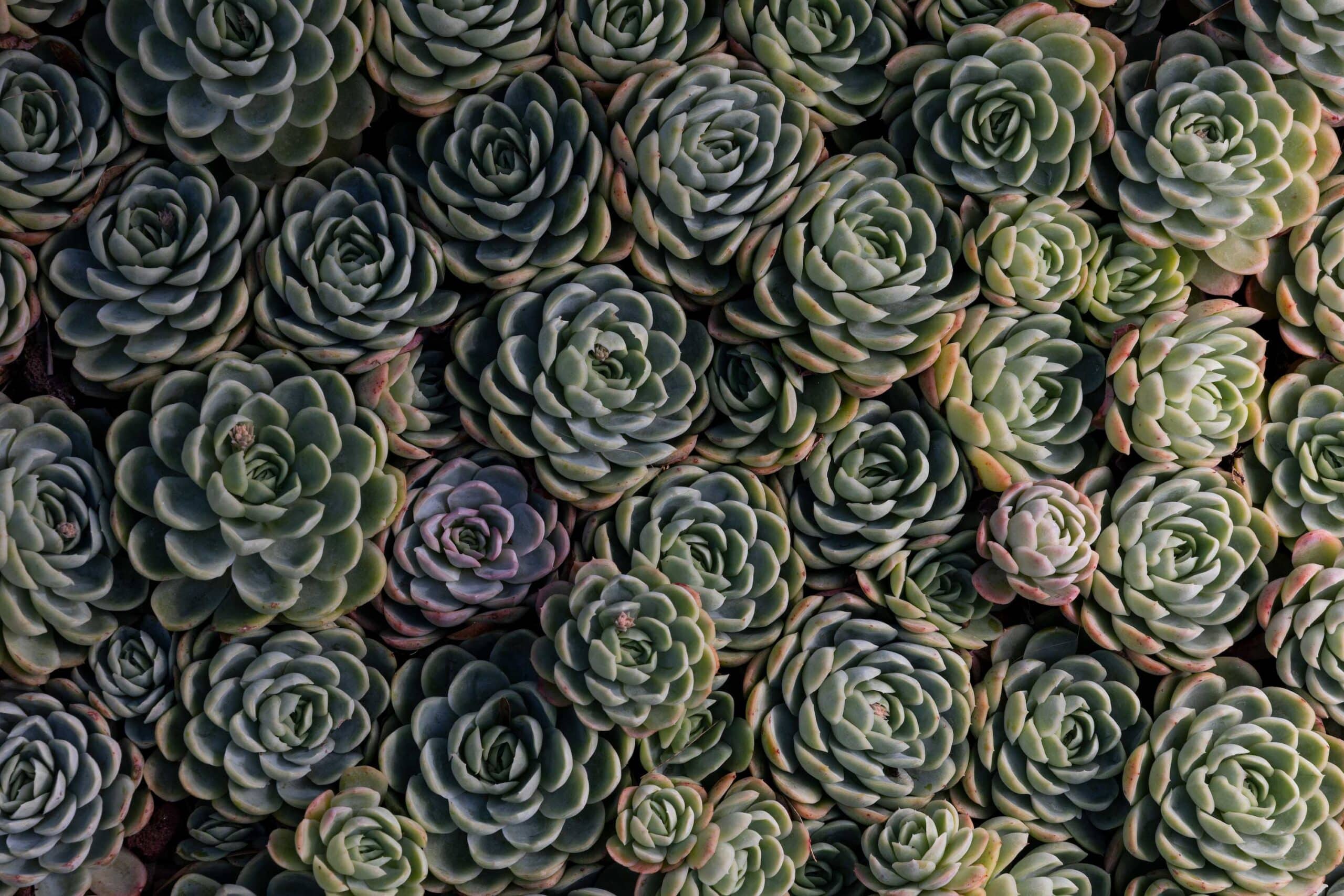
Plant Highlights
Plant Highlights
-
Hakea petiolaris
sea urchin hakea
Highlight Month:
November
Nativity:
It is native to a small area in the southwest part of Western Australia.
Growth Habit:
A shrub or small tree growing to 20 feet tall. Flowers bloom in late fall – early winter.
Growing Requirements:
Grows best in sun with well-drained and preferably acidic soil. Drought-tolerant.
Features:
The common name refers to the flowers, which are arranged in round clusters of up to 200 pale pink flowers with long styles that resemble a sea urchin or pincushion. The flowers attract nectar-feeding birds. After the flowers are done, woody seed pods form which cling persistently along the branches. The leaves are oval, gray-green and come to a sharp point at the tip.
Where at Lotusland:
There is one specimen in the Australian Garden, directly across from the Visitor Center.
-
Punica granatum ‘Wonderful’
pomegranate
Highlight Month:
November
Nativity:
Afghanistan, Pakistan, Iran to the Himalayas in India
Growth Habit:
Large shrubs or small trees, pomegranates are deciduous species of the Lythraceae, the plant family that also includes crapemyrtle and Cuphea.
Growing Requirements:
Pomegranates are drought tolerant and tolerate moderate frost (down to 14° F).
Features:
The seeds are covered with a brightly colored aril (usually red) that yields a tart juice. The juice is high in antioxidants and pomegranate juice products are enjoying an upsurge in popularity in the West. They have been cultivated for thousands of years in the Middle East and Mediterranean countries. ‘Wonderful’ is the pomegranate cultivar most commonly sold at grocery stores. It originates from the 1800’s in Florida and has larger fruit with a tangy flavor.
Where at Lotusland:
Deciduous Orchard and at the Cactus Garden entrance from the Olive Allée.
-
Aloe ramosissima
maiden’s quiver tree
Highlight Month:
November
Nativity:
South Africa, Namibia
Growth Habit:
Single trunk producing many slender dichotomously-branched divisions.
Growing Requirements:
Aloe ramosissima is native to very dry habitats, where years may pass between rain events, and requires excellent drainage to thrive in wet winter areas such as Santa Barbara.
Features:
The clear yellow tubular flowers occur in dense inflorescences in late fall. Most aloes have orange to reddish flowers, so these are particularly striking.
Where at Lotusland:
In the Aloe Garden near the shell pond.
-
Diospyros kaki ‘Hachiya’
Hachiya persimmon
Highlight Month:
November
Nativity:
China
Growth Habit:
Rough-barked deciduous tree with large, ovate leaves that turn brilliant shades of red and orange in fall.
Growing Requirements:
Persimmons require moderate winters (greater than 0° F) and do best in warm, but not extremely hot summers. To set fruit, they need only 100 hours of chill time.
Features:
Brilliant fall foliage and fruit. This cultivar is one of the astringent varieties that must be completely ripened to develop its sweetness. Other varieties can be eaten when crisp or allowed to soften.
Where at Lotusland:
Deciduous Orchard
-
Butia capitata
jelly palm
Highlight Month:
November
Nativity:
Brazil, Uruguay, Argentina
Growth Habit:
This palm grows as a single trunk (here several were planted closely so appear to be from one plant), with arching grey leaves. Slow growing, but drought tolerant and hardy to 10 degrees F. Some of the Butia capitata at Lotusland are hybrids with Jubaea chilensis.
Growing Requirements:
Plant in full sun and water regularly to establish.
Features:
The silvery gray foliage is handsome and the bright yellow or orange fruits in fall are not only decorative, but edible and the juice can be made into jelly.
Where at Lotusland:
Fern Garden, Aloe Garden, and Dracaena Circle
-
Ilex cornuta ‘Burfordii’
Burford holly
Highlight Month:
December
Nativity:
Ilex cornuta is native to East Asia; ‘Burfordii’ is a cultivar developed from a sport discovered on a plant growing in a Georgia cemetery around 1900.
Growth Habit:
A tree to 15 ft tall and 10 ft wide. It naturally forms a dense shrub, but can be pruned into a small tree by removing the lower limbs. It is easily shaped, and can even be espaliered along a wall.
Growing Requirements:
Full sun or partial shade with regular watering. It is adaptable to different soil types, and is drought-tolerant once established.
Features:
Burford holly has glossy dark green leaves with only one spine on the tip. The small white flowers are not an important ornamental feature, but are followed by clusters of large red berries in fall that last for months. Unlike some types of holly, Burford holly is self-fertile and a single plant will have prolific fruit.
Where at Lotusland:
There are two specimens growing in the Arboretum, an area between the Aloe Garden and the Japanese Garden which has many unusual trees and shrubs.
-
Nandina domestica
Heavenly Bamboo, Sacred Bamboo
Highlight Month:
December
Nativity:
China and Japan
Growth Habit:
A multi-stemmed shrub up to 8 feet tall, speading outward by underground runners.
Growing Requirements:
Nandina will grow in sun to light shade, and is adaptable to moist or dry soil. It is very hardy and resistant to oak root fungus, as well as most pests.
Features:
Although not related to bamboo, it has the same lacy, fine-textured foliage. The leaves are pinkish when young, then turn green when mature and finally bronze or red in autumn. Fall color is best in sunnier locations. Clusters of small white flowers are followed by bright red berries, though plants may have both fruit and flowers at the same time. There are many cultivars with variations of height, flower, and berry color.
Where at Lotusland:
There are over eighty Heavenly Bamboo growing in the Japanese Garden.
-
Berberis oiwakensis (syn. Mahonia lomariifolia)
Chinese holly
Highlight Month:
December
Nativity:
South-central China, Hainan, Myanmar, Taiwan, and Tibet
Growth Habit:
This architectural Berberis has it all! Long bluish-green leaves with 19-37 leaflets emerge atop corky 6-12’ stems. Fragrant bright yellow flowers appear in winter followed by edible powdery blue berries in spring, much beloved by birds. It makes a great statement in a tropical or woodland garden, even when not in bloom.
Growing Requirements:
This plant prefers moist, well-drained soils, part-shade, and is hardy down to USDA Zone 8, and possibly Zone 7 with minor damage.
Features:
There is significant debate over the correct name of this species with all Mahonia species now incorporated into the genus Berberis. The featured plant was long known as Mahonia lomariifolia, referencing the leaves appearing similar to the fern genus Lomaria (now Blechnum). B. oiwakensis is one of the parents of the B. × hortensis (Mahonia × media) hybrids, most popular being ‘Charity’ and ‘Winter Sun’.
Where at Lotusland:
Berberis oiwakensis can be found in the Japanese Garden and across the main drive in the Tropical Garden at Lotusland.
-
Laelia anceps
Highlight Month:
December
Nativity:
Mexico to Honduras
Growth Habit:
This orchid species grows epiphytically on trees. Specimens may be mounted directly on the trunk of a suitable tree or attached to a plank and hung in the garden.
Growing Requirements:
Laelia anceps should be positioned in light to moderate shade. Established plants can withstand some drought, but do best when watered regularly. Bloom production can be enhanced by monthly applications of dilute liquid fertilizer.
Features:
Laelia anceps is one of the easiest orchids for outdoor culture in Southern California. It survives temperatures as low as 22° F and does not mind hot summers.
Where at Lotusland:
There is a large hanging specimen in the Upper Bromeliad Garden.
-
Camellia sasanqua
sasanqua camellia
Highlight Month:
December
Nativity:
Japan
Growth Habit:
Evergreen shrub reaching up to 12′ tall.
Growing Requirements:
Grow these camellias in soil enriched with plenty of organic material. While they prefer a slightly acidic soil, they will tolerate more alkaline conditions. Keep uniformly moist and plant in partial shade.
Features:
Camellia sasanqua blooms earlier than other Camellia species and makes a good addition to the late-fall/winter garden. Flowers range in color from white to many shades of pink and may be single or double.
Where at Lotusland:
Lotusland’s Japanese Garden is home to several cultivars of C. sasanqua including ‘Bonanza’, ‘Jean May’, ‘Mine-no-yuki’, ‘Shôwa-no-sakae’ and ‘Shishigashira’.


